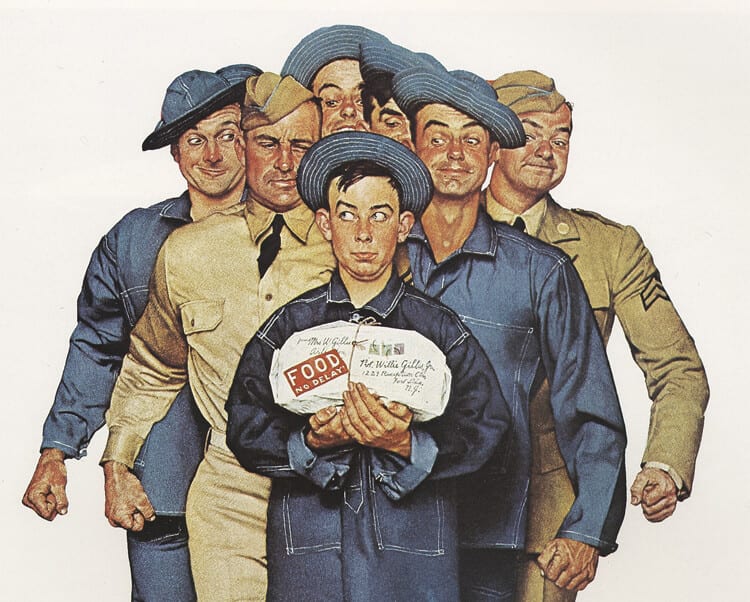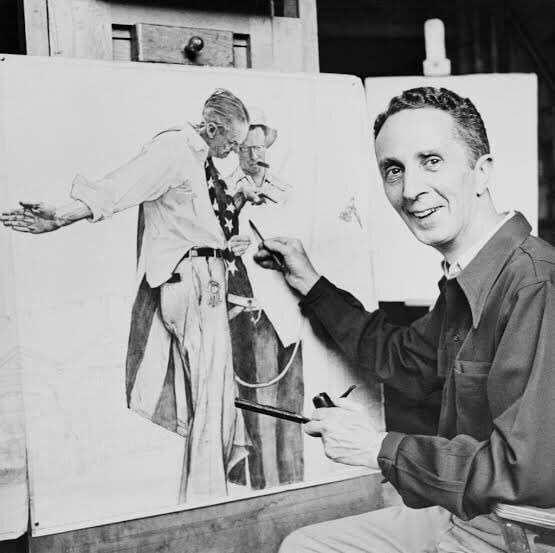Norman Rockwell was a popular American painter in the mid-20th century. Known for his commercial illustrations, Norman Rockwell’s work often reflected American culture.
Find out more about his life and works of art below.
Norman Rockwell Biography
Early Life
Norman Rockwell was born in New York in 1894 to parents, Jarvis and Anne Mary “Nancy” Rockwell. Norman was the couple’s second child, born two years after their eldest son, Jarvis. The family lived in New York City for Rockwell’s entire childhood.
Education
At the early age of 14, Rockwell enrolled in The New York School of Art where his first studies began. Two years later in 1910, he went on to study at the National Academy of Design.
Rockwell later transferred to the Art Students League in Manhattan, NY. It was there where he met famous painters Thomas Fogarty and George Bridgman. Both of whom taught Rockwell the technical skills that aided in his success.
Marriages
Norman Rockwell married three times. His first wife was Irene O’Connor, and the couple married in 1916. After only being married for a short five years, the couple divorced in 1921.
To cope with his divorce, Rockwell moved to California for a brief time. It was there Rockwell met and married schoolteacher Mary Barstow in 1930. The couple returned to New York shortly after their marriage. They had three children, Jarvis, Thomas, and Peter. After living in NY for almost a decade, the family moved to Arlington, Vermont in 1939.
A decade and a few years later, Rockwell moved his family once more. The family then settled in Stockbridge, Massachusetts. The move was due to Rockwell’s wife, Mary, having a mental illness. They had moved so Mary could begin treatment at a psychiatric hospital.
In 1959, almost 30 years after their marriage began, Mary died of a heart attack. Two years later, Rockwell married his third wife, Mary Leete “Mollie” Punderson. The couple remained married until Rockwell’s death in 1978.
Death
Rockwell died of emphysema at age 84 in his Stockbridge, Massachusetts home.
Before his death, Rockwell helped establish the safekeeping of his work. The Norman Rockwell Museum was established near his home in Stockbridge, Massachusetts. The museum’s collection includes more than 700 original Rockwell paintings, drawings, and studies.
Norman Rockwell an American Illustrator
Norman Rockwell created over 4, 000 original works. He even painted portraits of several US Presidents. The most famous being President Kennedy.
Rockwell also illustrated more than 40 books in his lifetime. Among those books were the successful Tom Sawyer and Huckleberry Finn.
In the early 1940’s, people knew Norman Rockwell as a talented illustrator. But most knew Rockwell’s name from the Saturday Evening Post, where most of his narrative illustrations were on display each week.
Rockwell’s detailed narrative style coined him a successful career as an illustrator. His work painted a relatable story for his viewers but leaned more on the illustration side of art. Because of this, critics thought of him as a superb illustrator but only a fine artist.
It wasn’t until his later years, that he was a serious artist. As Rockwell parted from his relationship with the Post, he dived into world issues. Rockwell’s later work turned into provocative images that sparked movements and his reputation.
Norman Rockwell Paintings
Norman Rockwell created many works of art during his career. His images portray everyday life and have remained highly sought after. At one time, Rockwell’s held the title for most expensive American painting ever sold.

Rockwell’s early work depicted American life and values. His war works sparked emotion and inspiration during World War II. While his later work became icons for the Civil Rights movement and world poverty issues. First seen as an idealistic illustrator, Rockwell’s reputation grew into an emotion-sparking artist.
Here is a look at five of his most famous works of art:
Willie Gillis
In the early 1940’s, people knew Norman Rockwell for his artwork about war. More specifically people knew him for his Willie Gillis series.

Rockwell captured the emotions of his viewers with his character, Willie. Published two years after the start of World War II, viewers followed Willie’s story each week. The series depicted a young soldier’s career from his induction to his discharge.
The Saturday Evening Post published the complete Willie Gillis series. The magazine featured Willie Gillis on eleven covers between 1941 and 1946. The series is a hallmark of Rockwell’s war works.
Four Freedoms
Rockwell’s inspiration for his Four Freedoms series came from Franklin D. Roosevelt’s 1941 state of the union speech. FDR referenced essential human rights that the government should protect. His speech became known as the “Four Freedoms Speech”.

Rockwell’s Four Freedoms are a series of paintings created in 1943. The series included works titled Freedom of Speech, Freedom of Worship, Freedom from Want and Freedom from Fear.
The Saturday Evening Post published each painting as a separate cover between February and March of 1943. After, the news outlet partnered with the U.S Department of Treasury to raise war bonds. Rockwell’s Four Freedoms became a successful touring exhibition. The art tour helped raise $132 million for the war effort through the sale of war bonds.
Four Freedoms was Rockwell’s most popular work. After publication, the Post received millions of reprint requests from viewers. It was then issued as stamps, posters, and other marketing material. By the end of World War II, the Office of War Information had printed four million posters of Four Freedoms.
Rosie the Riveter
Rosie the Riveter became a popular symbol in the WWII era and is still a symbol for American feminism today. You may have seen the “You Can Do It” poster by J. Howard Miller from World War II. But did you know that wasn’t our first introduction to Rosie the Riveter?

The term “Rosie the Riveter” first came from a 1942 song by Redd Evans and John Jacob Joeb. But it was Miller’s famous poster that made Rosie into a national symbol for female industrial workers.
Rockwell’s rendition of Rosie was published in 1943 by the Saturday Evening Post. His illustration depicted a woman industrial worker on her lunch break. She’s seen with a rivet gun over her lap and Hitler’s manifesto under her dirty boot. “Rosie” is the name written on her lunchbox. It gives recognition to her iconic status.
Saying Grace
Saying Grace was another of Rockwell’s war works for The Saturday Evening Post. The magazine published his illustration as their Thanksgiving issue in 1951.

Rockwell’s painting, Saying Grace, depicts a woman and her young son praying in a restaurant. As they are praying, other patrons in the restaurant observe them.
Rockwell got his inspiration from a reader of his publications. The reader told a similar story, of seeing a Mennonite family praying at a local diner. Inspired by the story, Rockwell began visiting several New York diners to get the scene laid out in his head.
Rockwell succeeded; his viewers said the scene was as perfect as he could create it. Saying Grace was a fan favorite of Rockwell’s work. In 1955, the Post viewers even voted it their favorite cover.
Problem We All Live With
Within his contract with The Saturday Evening Post, Rockwell often expressed his frustration. Rockwell felt the magazine was depicting an idealistic image of American life. His interests lied in showing civil rights and poverty issues.

After publishing his last cover in 1963, Rockwell ended his contract. He then spent the next ten years painting for Look magazine. During this time, his reputation as a serious artist improved. This was in part due to his work beginning to depict serious world issues.
Painting for Look, Rockwell created his iconic The Problem We All Live With. Inspiration for the painting came from the story of Ruby Bridges.
Ruby Bridges was the first African American girl to attend an all-white elementary school. Because of the threats against her, several U.S Marshalls had to escort Ruby. This was illustrated in Rockwell’s art which also depicts Ruby passing a wall with racial slurs.
The Problem We All Live With is an iconic image of the Civil Rights Movement. It reminds us of how important art is to the progress of change.
Looking for artwork by Norman Rockwell? Contact us at Dane Fine Art for more details. With over 50,000 pieces of artwork in our collection, we can help you find what you are looking for. Call Now 267-687-8378.

